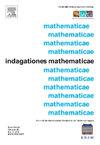On arithmetically defined hyperbolic 5-manifolds arising from maximal orders in definite Q-algebras
IF 0.8
4区 数学
Q3 MATHEMATICS
引用次数: 0
Abstract
Using the quaternionic formalism for the description of the group of isometries of hyperbolic 5-space we consider arithmetically defined 5-dimensional hyperbolic manifolds which are non-compact but of finite volume. They arise from maximal orders in the central simple algebra of degree 4 where denotes a definite quaternion -algebra. The affine -group scheme determines an integral structure for the algebraic -group obtained by base change. The group is an inner form of the special linear -group . Each torsion-free subgroup determines a hyperbolic 5-manifold, to be denoted . Given a principal congruence subgroup , we determine the number of ends and the dimensions of the cohomology groups at infinity of the manifold .
定q代数中由极大阶产生的算术定义双曲5流形
利用四元数的形式描述了双曲5空间的等距群,考虑了非紧的有限体积的算术定义的五维双曲流形。它们起源于4次中心简单代数M2(D)的最大阶Λ,其中D表示一个确定的四元数q代数。仿射z群方案SLΛ决定了由碱基变化得到的代数q群G=SLΛ×ZQ的一个积分结构。群G是特殊线性q群SL4的内形式。每个无扭转子群Γ∧SLΛ(Z)决定一个双曲5流形,表示为XG/Γ。给定一个主同余子群Γ(pe),我们确定了流形XG/Γ(pe)无穷远处的上同调群的端数和维数。
本文章由计算机程序翻译,如有差异,请以英文原文为准。
求助全文
约1分钟内获得全文
求助全文
来源期刊
CiteScore
1.20
自引率
16.70%
发文量
74
审稿时长
79 days
期刊介绍:
Indagationes Mathematicae is a peer-reviewed international journal for the Mathematical Sciences of the Royal Dutch Mathematical Society. The journal aims at the publication of original mathematical research papers of high quality and of interest to a large segment of the mathematics community. The journal also welcomes the submission of review papers of high quality.

 求助内容:
求助内容: 应助结果提醒方式:
应助结果提醒方式:


